|
|
|
Sort Order |
|
|
|
Items / Page
|
|
|
|
|
|
|
| Srl | Item |
| 1 |
ID:
145663


|
|
|
|
|
| Summary/Abstract |
‘Come, Make in India’, India’s Prime Minister has invited global firms to invest and manufacture in India and also to promote exports. As with this campaign, India has given a scope of promising growth to the companies which is also been seen to solve India’s multiple economic problems. Many countries have shown their interest to invest in India and one of them is South Korea. Now the question arises whether companies from South Korea in this competitive environment can mark their presence in India—a nation of cultural diversity, which can affect the initial start-ups, if ignored. Apart from the historical cultural ties, there are cross-cultural differences between South Korea and India. So, this paper aims to build up a study that brings together the parity and cross-cultural differences between South Korea and India. The paper opens with the discussion about the various historical, cultural and poetic relations to describe the scenario between the two countries, whereas for the analysis, a macro-meso-micro framework has been used to answer the research question. The three-level analysis helps this paper to see the overlooked influence of culture from a broader perspective. The results of the study reveal a list of cultural adaptations suited for South Korean start-ups to run businesses in India by avoiding the cultural threats and contribute to the existing literature. The study findings could be used by companies, marketers and practitioners to devise and re-vamp their strategies in India, and it will also serve as a cultural guide for them.
|
|
|
|
|
|
|
|
|
|
|
|
|
|
|
|
| 2 |
ID:
185558
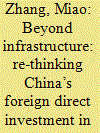

|
|
|
|
|
| Summary/Abstract |
Using a non-state-owned Chinese company LONGi as a case study, this paper analyses the motives, impact and acceptance of Chinese investment in Malaysia. The paper compares Chinese investment in manufacturing sector with the ones in infrastructure sector to obtain a more rigorous assessment than previous studies. In contrast to the narrative depicting Chinese investment into a single superstructure that generates a monolithic and deleterious impact couched under the Belt and Road Initiative, I argue that the motives and impacts of Chinese investment vary significantly with business nature and practices, and thus generating different acceptance level towards Chinese-funded project in host-site. LONGi’s case elucidates why Chinese investment in manufacturing encountered little political upheaval, while BRI projects in infrastructure sectors are often disputed. The analytical benefits and policy implications arising from this specific case study of Malaysia should be helpful to deepen our understanding of Chinese outward investment in not only other emerging economies in ASEAN but also broader region of the Asia-Pacific.
|
|
|
|
|
|
|
|
|
|
|
|
|
|
|
|
| 3 |
ID:
110252
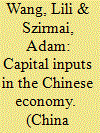

|
|
|
|
|
| Publication |
2012.
|
| Summary/Abstract |
This paper presents new estimates of capital inputs in the Chinese economy. Estimates are made for the total economy (1953-2007), for the industrial sector (1953-2007) and for manufacturing (1985-2007). The capital input estimates for industry and manufacturing are also broken down by thirty regions. The paper makes a systematic attempt to apply SNA (System of National Accounts) concepts to the estimation of capital inputs, according to the Perpetual Inventory Method. It makes a clear distinction between capital services from a productivity perspective and wealth capital stocks. The paper provides a detailed analysis of the relevant Chinese statistical concepts and data. It provides an explanation of the procedures followed in constructing the new national and regional capital input series.
|
|
|
|
|
|
|
|
|
|
|
|
|
|
|
|
| 4 |
ID:
082246
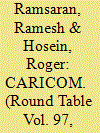

|
|
|
|
|
| Publication |
2008.
|
| Summary/Abstract |
The article examines economic performance in the CARICOM Region against the background of the challenges facing the growth of both regional and international trade. It argues that CARICOM has not only failed to create the expected dynamic in intra-regional trade but has also failed to lay the groundwork for a competitive and efficient manufacturing sector that could exploit foreign market opportunities in an increasingly transparent global economy. A strategy for greater competitiveness needs to embrace a broad range of non-price factors
|
|
|
|
|
|
|
|
|
|
|
|
|
|
|
|
| 5 |
ID:
171884


|
|
|
|
|
| Summary/Abstract |
For more than three decades the goal of becoming “the factory of the world” has been at the core of China’s development strategy. This strategy, in combination with high rates of domestic investment and low rates of consumption, has made Chinese production the most manufacturing intensive in the world. But as its wages have risen, China’s competitiveness in the most labor-intensive manufacturing industries has eroded. Its ability to assemble products remains a major source of its exports, but it has also tried to shift toward more sophisticated value-added production domestically. Chinese domestic spending has shifted away from investment toward consumption as citizens’ income has grown. Like Americans, Chinese are also spending more on services than on manufactured goods. All of these changes are fundamentally altering the structure of China’s production, reducing the role of manufacturing and increasing the skill levels of workers in manufacturing. This paper reviews the challenges posed by these developments for China’s long-term goal of achieving more inclusive growth. It presents evidence that the commonly held perceptions that Chinese manufacturing employment growth is robust are wrong. In fact, such growth has peaked and China is now following a pattern of structural change that is typical of a more mature emerging economy, in which the share of employment in manufacturing declines as workers are increasingly employed in services.
|
|
|
|
|
|
|
|
|
|
|
|
|
|
|
|
| 6 |
ID:
119152
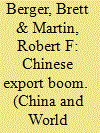

|
|
|
|
|
| Publication |
2013.
|
| Summary/Abstract |
From 2000 to 2007, Chinese exports grew at a phenomenal pace. Our paper uses finely detailed Chinese export data (8-digit Harmonized Commodity Description and Coding System codes) combined with US trade data to explore how this was achieved. Although general explanations such as China's exchange rate policy no doubt played a role, we find that sector-specific stories, effective Chinese industrial policy and fortuitous timing were more critical. The detailed trade data reveal that "new" technology goods, such as cell phones, LCD screens and laptops, played a key role. Finally, we use the data to examine the relationship between Chinese exports and global manufacturing, in particular US manufacturing employment. We find that competition from China in both domestic and foreign markets likely contributed to a significant decline in USA manufacturing employment, but that relatively low US investment and slow GDP growth in the US following the 2001 recession played an equally important role.
|
|
|
|
|
|
|
|
|
|
|
|
|
|
|
|
| 7 |
ID:
161777
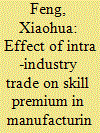

|
|
|
|
|
| Summary/Abstract |
In making use of the panel data in 27 manufacturing industries, this paper examines the recent increase in skill premium in China's manufacturing. The paper argues that the recent increase in skill premium in Chinese manufacturing can be partly attributed to the decline in intra-industry trade. A reasonable explanation on this is that the decline in intra-industry trade occurred in the period studied is associated with a decrease in output. This led to a reduction in relative demand of low-skilled workers, which supports the hypothesis of the output-skill substitutability, and finally an increase in skill premium. Further, this paper finds that the negative effect of intra-industry trade on skill premium is larger for high-skilled manufacturing than low-skilled manufacturing. One more result in this paper is that the increase in capital input reduced the skill premium in Chinese manufacturing. The empirical evidence is consistent with a modified model of intra-industry trade with differentiated products and three factor inputs: high-skilled labor, low-skilled labor and capital.
|
|
|
|
|
|
|
|
|
|
|
|
|
|
|
|
| 8 |
ID:
103952


|
|
|
| 9 |
ID:
189189
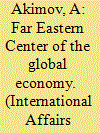

|
|
|
|
|
| Summary/Abstract |
RECENT statistics suggest that China, Japan, and South Korea are increasingly forming an economic unit comparable to the West. One naturally wonders whether this unit is going to become a formal association of some kind and whether such an association would counterbalance the West. There are no answers yet, but the three East Asian countries do possess the resources to form an economic center equal in scale and significance to the West. Let us tentatively label China, Japan, and South Korea the Far Eastern Economic Center (FEEC).
|
|
|
|
|
|
|
|
|
|
|
|
|
|
|
|
| 10 |
ID:
175571
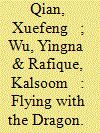

|
|
|
|
|
| Summary/Abstract |
As a large trading nation, China competes with importing countries’ domestic and third‐country markets but also creates growth opportunities for exporters. Most studies on China trade shocks or “China shocks” focuse on the impacts of import competition on developed economies. The present paper complements research on China shocks by exploring the other side of the trade exposure to China – China as the largest importer, rather than as an exporter. We analyze the effects of export expansion into China on the local labor markets of the exporting developing countries for the years 1992 to 2018. Using detailed export and employment data, we estimate employment pattern variations in manufacturing industries with exports from other developing countries as instruments for export exposure. We find that the increase in trade exposure to China in the world economy has caused extensive job gains in manufacturing industries in developing countries that were exporters. On average, our estimations show that this trade exposure created approximately 1.5 million additional jobs from 1992 to 2018, which made an important contribution to manufacturing industries in developing countries. Our empirical analysis also shows that trade had stabilizing effects on employment in the countries in our sample generally.
|
|
|
|
|
|
|
|
|
|
|
|
|
|
|
|
| 11 |
ID:
109432


|
|
|
|
|
| Publication |
2011.
|
| Summary/Abstract |
This paper estimates the response of manufacturing sectors' natural gas demand to price and output changes. The average response to future changes in absolute and relative prices of the manufacturing industry in an OECD country depends on the mix of manufacturing industries, particularly with respect to energy intensity and substitution opportunities in production. We estimate short and long run demand elasticities using a shrinkage estimator, which allows heterogeneous demand responses across industries for each country. Our results show that price and output elasticities are heterogeneous within the same manufacturing sector across countries. Furthermore, an output contraction due to e.g. demand shocks will generally have larger negative effects on gas demand than increases in natural gas prices.
|
|
|
|
|
|
|
|
|
|
|
|
|
|
|
|
| 12 |
ID:
141339
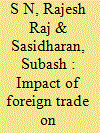

|
|
|
|
|
| Summary/Abstract |
This study attempts to investigate the impact of international trade on the manufacturing employment and wages in India over the period 1980–2005. Given India’s abundant labour force, the empirical evidence will provide an indication on the role of trade openness in labour market in terms of employment and wages. We employ three standard modelling approaches, namely, factor content, growth decomposition and panel data modelling approaches, to verify the role of trade on employment and wages. We use panel data at the industry level obtained from Annual Survey of Industries (ASI) and World Bank trade data set. Our results suggest that international trade has not had any significant impact on employment generation in the manufacturing sector in India. While there is little evidence on any significant effect of export orientation on employment, import penetration had a detrimental effect on employment generation.
|
|
|
|
|
|
|
|
|
|
|
|
|
|
|
|
| 13 |
ID:
121193
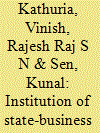

|
|
|
|
|
| Publication |
2013.
|
| Summary/Abstract |
Empirical studies on total factor productivity growth (TFPG) in developing countries highlight trade openness, research and development and market structure as being the most important determinants of TFPG. The role of institutions remains overlooked in the literature on the determinants of TFPG. In this article, we look into the role of institutional quality as captured by effective state-business relationships (SBRs) in influencing TFPG, using Indian manufacturing as a case study. By SBRs we mean a set of highly institutionalized, responsive and public interactions between the state and the business sector. To compute TFPG, we use firm level data for both the formal and informal manufacturing sectors. We correct for the simultaneity bias associated with the production function approach for TFPG estimation by employing a method developed by Levinsohn and Petrin. We propose measures of effective SBRs for 15 Indian states over the period 1994-2005, and then use them in TFPG equations to estimate the effect of SBR on TFPG. The results indicate that SBR has positively affected the TFPG of Indian industry. The effect, however, is primarily for the formal sector.
|
|
|
|
|
|
|
|
|
|
|
|
|
|
|
|
| 14 |
ID:
108798
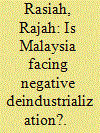

|
|
|
|
|
| Publication |
2011.
|
| Summary/Abstract |
This paper seeks to examine whether Malaysia is facing negative deindustrialization by examining value-added, trade and productivity trends over the period 1990-2005. The evidence produced in the paper is concrete enough to confirm that Malaysia is facing negative deindustrialization. While it is typical, as part of the process of structural change, to see a rise and fall in the share occupied by manufacturing in the GDP, the evidence shows that Malaysia is indeed facing premature deindustrialization with a trend slowdown in manufacturing value-added, trade performance and productivity since 2000. Not only has the trade performance of manufacturing been falling, manufacturing labour productivity has also slowed down, with the key sectors such as electric-electronics, textiles and transport equipment showing either negative or low productivity growth since 2000. Malaysian industrial policies have been fairly successful in connecting with the global value chains of multinationals and in developing resource-based industries, but have not achieved the same success in stimulating their transformation to high value-added activities. The lack of effective institutional change, partly explained by ethnic policies, is advanced as the prime reason for the setting in of negative deindustrialization in Malaysia.
|
|
|
|
|
|
|
|
|
|
|
|
|
|
|
|
| 15 |
ID:
095590


|
|
|
|
|
| Publication |
2010.
|
| Summary/Abstract |
This paper explores the relationship between beers and island development, using a global sweep but with a special reference to the insular Pacific. It adopts a discriminatory approach, touching upon the role and impact that niche and bouquet beer manufacturing can have on the socioeconomic development of small islands. It departs from a personal observation: many small island jurisdictions have their own brewery. Indeed, the brewery could also be the island territory's largest indigenous manufacturing concern. While small islands are associated with low manufacturing capacity and diseconomies of scale, nevertheless 'a local brewery' comes across, in many cases, as a profitable and glaring exception that speaks to the attractions and virtues of locality branding.
|
|
|
|
|
|
|
|
|
|
|
|
|
|
|
|
| 16 |
ID:
163422
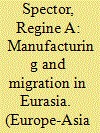

|
|
|
|
|
| Summary/Abstract |
This article investigates the social foundations of apparel manufacturing in Kyrgyzstan. Drawing upon interviews and a survey of Bishkek-based workshop owners, a bottom-up analysis finds that many are family businesses that started producing clothing after the country’s independence in 1991. I discuss here how they acquired the capital and knowledge necessary for this business, and how they mobilised a variety of migration-related experiences and relationships—often related to bazaar work—to compete in the sector. The findings contribute to a growing literature on how migration can facilitate family-based manufacturing in the post-Soviet region, although not without significant costs and challenges.
|
|
|
|
|
|
|
|
|
|
|
|
|
|
|
|
| 17 |
ID:
151934


|
|
|
| 18 |
ID:
143537


|
|
|
|
|
| Summary/Abstract |
One of the most prominent trends in Latin America in the 2000s has been the proliferation of bilateral free trade agreements (FTAs) across the Pacific basin. Beginning with the path-breaking Chile-Korea FTA in 2004 up to the Costa Rica-Singapore FTA in 2013, the past decade has seen the negotiation of twenty-two cross-Pacific accords. China, too, has jumped on to the cross-Pacific FTA bandwagon, including its negotiation of separate bilateral FTAs with Chile (2006), Peru (2009), and Costa Rica (2011). This paper analyzes the origins, content, and preliminary outcomes of these three China-Latin America FTAs. The findings are threefold: 1) in contrast with other cross-Pacific FTAs, which include at least one developed country, the three FTAs analyzed in this paper constitute “south-south” FTAs; yet, in contrast with other south-south FTAs, these three China-Latin America accords approximate WTO+ standards vis-à-vis the World Trade Organization (WTO) and its new trade agenda (services, investment, and intellectual property rights); 2) although the motives for negotiating these developing- developing country accords varied, on the part of China and the countries themselves, this did not disrupt the march toward WTO+ status; and 3) while all three of these FTAs elude standard theoretical explanations for the negotiation of bilateral FTAs, the three Latin American countries do share similar reform trajectories and institutional affinities, which sheds light on the decision and capacity of each to negotiate a bilateral FTA with China.
|
|
|
|
|
|
|
|
|
|
|
|
|
|
|
|
| 19 |
ID:
177139
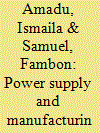

|
|
|
|
|
| Summary/Abstract |
Inadequate and unstable power supply constitute a major constraint to industrial production in Cameroon. This paper evaluates the long-term impact of power deficits on the country's manufacturing growth, using a Fully Modified Ordinary Least Square Method, and selected data from 2016 World Development Indicators, covering the period 1977–2014. For each variable used in the estimations, only data for Cameroon was retrieved for the period under study. The findings reveal that there is a strong and positive correlation of 0.904256/1 between power supply and manufacturing growth in the long-term. Moreover, a percentage decrease in electricity supply reduces annual manufacturing growth and gross capital formation by 0.07% and 0.28% respectively. Furthermore, Foreign Direct Investment inflows augment manufacturing value added by 0.39% yearly. It is recommended that: first, the government of Cameroon should increase its investments in the energy sector to boost power supply by 10% annually, in order to raise manufacturing growth by 0.7% in a year and 7% in a decade. Secondly, incentives to encourage private investments in the energy sector should be put in place to spur power production and supply. Overall, the findings imply that power supply must remain at the epicenter of economic and industrial policies in Cameroon.
|
|
|
|
|
|
|
|
|
|
|
|
|
|
|
|
| 20 |
ID:
188568


|
|
|
|
|
| Summary/Abstract |
Conflicts severely depress the manufacturing sector of affected countries and jeopardize its recovery once peace is re-established. Yet, I claim that donors' commitment to restore and develop infrastructures to generate, distribute, store and manage energy may boost an upswing of the manufacturing sector in post-conflict settings. This is because, first, as opposed to conventional developmental aid, post-conflict aid is proven to be unusually productive and unlikely to trigger the appreciation of the real exchange rate. Second, because restoring and enhancing energy infrastructures is expected to increase the return on investments in the manufacturing sector. To test my hypothesis, I resort to a cross-section time-series two-stage least squares multivariate analysis covering 45 post-conflict countries between 1970 and 2013. I find that donors' commitment to rebuild and enhance energy infrastructures in post-conflict countries has positive effects on the manufacturing sector of recipient countries both in the short and in the medium term. These findings contribute both to shed more light on the impact of foreign aid in fragile and post-conflict countries, and to the literature investigating the impact of electrification in developing economies.
|
|
|
|
|
|
|
|
|
|
|
|
|
|
|
|
|
|
|
|
|